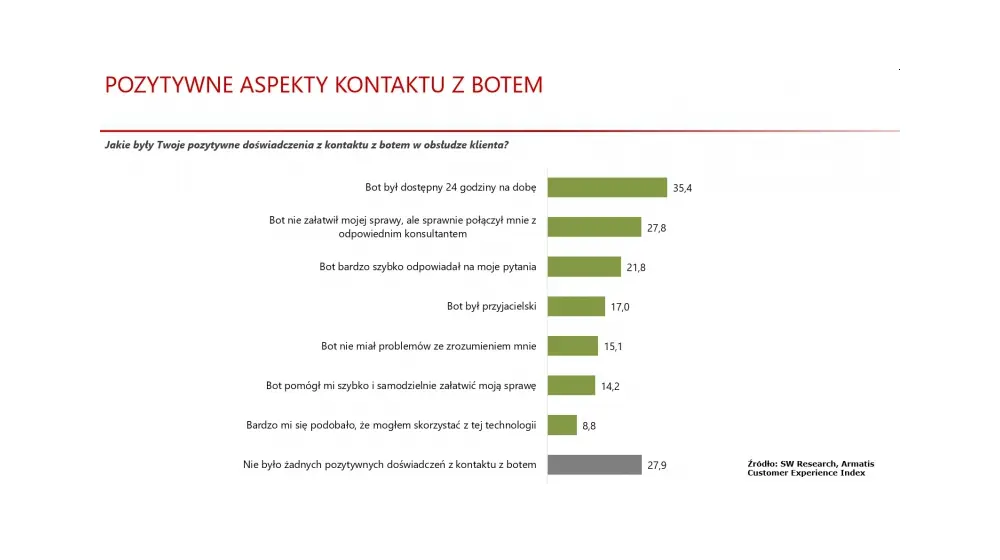
After interacting with a bot, Poles most frequently (31%) feel frustration, with 11.2% experiencing it to the extent that they shared their negative experience with someone. In contrast, 15% of respondents expressed satisfaction with bot service, with an additional 2% sharing their positive experience with friends. 40.3% of Poles served by bots hold a neutral opinion on them.
Positive and Negative Aspects of Bot Interaction
- The percentage of Poles feeling frustrated after interacting with a bot is nearly half that of the global rate, where according to a recent UJET study, as many as 80% of consumers experience discomfort after encountering a bot in customer service - says Krzysztof Lewiński, country director at Armatis Polska, a customer service and sales outsourcing provider.
The most frequently cited positive aspects of bot service among Poles include:
- 24/7 availability (35%),
- efficient connection to a consultant when the bot cannot resolve the issue (28%),
- quick answers to questions (22%).
On the other hand, negative feelings among those served by bots were mainly due to:
- the inability to directly contact a human without going through the bot (39%),
- the bot’s inability to help the customer (38%),
- the bot not understanding or responding appropriately (37%).
A total of 15% of respondents report no negative experiences. However, the majority (71%) prefer human service, even if it means waiting in line. Almost one in five people (18%) would choose immediate service by a chatbot, and one in ten would choose immediate voice bot assistance.
The Growth of AI-Supported Customer Service
As many as 35% of respondents believe that companies should implement bots in their service channels, but with the option to easily switch to a human. A slightly smaller portion (32%) thinks bot service should be one of the options, not a mandatory start. One in four believes bots should identify the issue and then connect to a human. Twenty-two percent of respondents view the implementation of bots in customer service negatively.
- Responses to this last question clearly show Poles` openness to bots in customer service centers if certain conditions are met, such as the option to switch to a human at any time or the non-compulsory nature of bot service - comments Krzysztof Lewiński. - It is worth adhering to this, given the generally negative sentiment among Poles toward bots in customer service. However, I am convinced this will change due to the increasing quality of chatbots and voice bots, with the advent of a new generation of AI-based solutions.
The Armatis Customer Experience Index study was conducted by SW Research on behalf of Armatis in April 2023. The main goal of the study was to examine the experiences and opinions of Poles regarding AI-based bot customer service.
COMMERCIAL BREAK
New articles in section Marketing and PR
Dance in the media mirror. Between culture, business and viral fame
KFi
Over 78,000 media pieces, 1.6 billion potential views, and 197,500 social media mentions-dance in Poland is no longer niche. With a combined media value exceeding PLN 800 million, it now outperforms MMA, handball, and hockey.
PR in Poland. Ranking of the largest public relations agencies 2025
KFi
The smallest teams often generate the most publications, and agencies outside Warsaw are increasingly capturing media attention. This unexpected distribution of power is one of the key findings from the 2025 PR Agency Ranking in Poland, developed by Widoczni and IMM.
Connected TV and borderless advertising. The ID5 report
KFi
Viewers are moving away from cable TV. And they are doing it en masse. Already 86% of Europeans watch content via Connected TV and global ad spend in this segment is set to double by 2028. The industry is undergoing a communication revolution.
See articles on a similar topic:
Large Online Ads vs. AdBlock. Poland Leads in Both Metrics
BARD
Large-format online ads make up 14% of Poland's online market, according to analyses by Gemius. This is the highest percentage among all surveyed markets. Paired with data on the rising popularity of ad-blocking - done by one-third of Polish internet users - it raises questions about the future of these ads.
Dietary Supplements. How to Distinguish Information from Marketing
Ewa Zygadło-Kozaczuk
Where can you find reliable information about dietary supplements, and how can you distinguish factual information from advertising? The answer is not straightforward. In fact, additional doubts arise.
Email Marketing Done Right. How to Avoid Ending Up in SPAM
BARD
One in three Poles receives between 10 and 20 promotional emails daily, and more than half receive at least 10, according to a study by Redlink. For an email to stand out among the competition and be read by the recipient, three key factors are essential, capturing the most attention from recipients.
LabOOOratorium. Education, Business and Win-Win-Win Cooperation
fundacja OOO
How to combine diversifying activities in kindergartens and schools with setting innovative trends in education and social engagement of businesses? The educational foundation Ogólnopolski Operator Oświaty and the company Musicon show how to do it right.





























